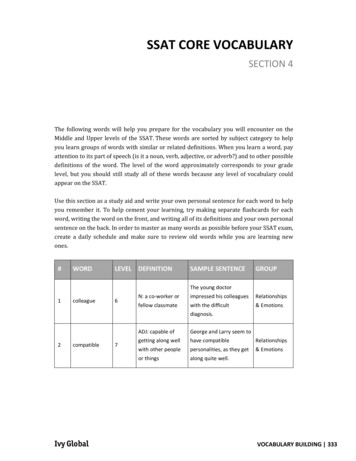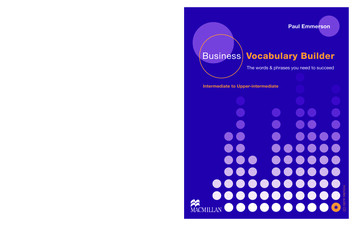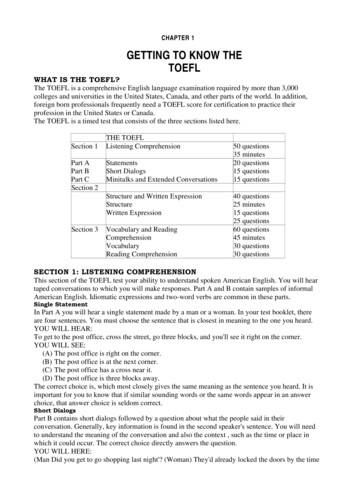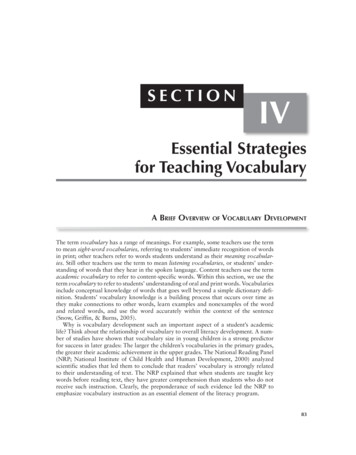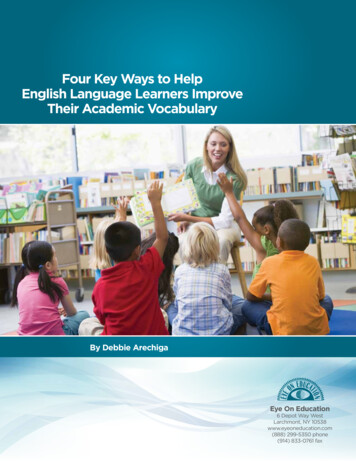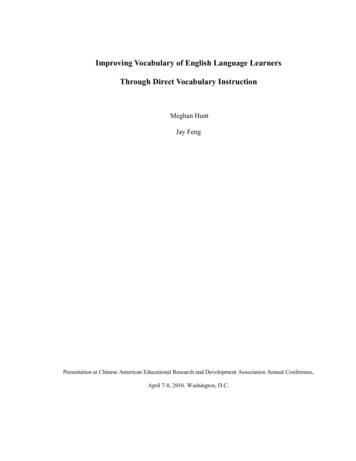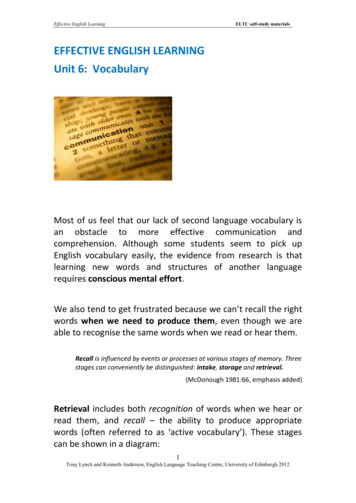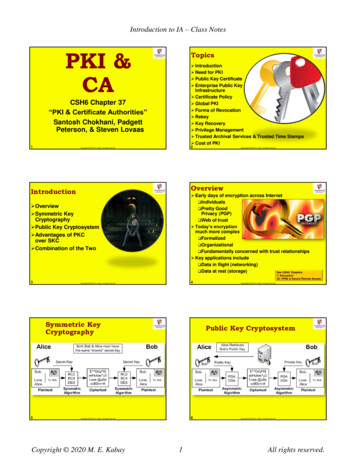
Transcription
Published in “Insights on Learning Disabilities” 2(1) 33-45, 2005Effective Vocabulary InstructionBy Joan SeditaWhy is vocabulary instruction important?Vocabulary is one of five core components of reading instruction that are essential to successfully teachchildren how to read. These core components include phonemic awareness, phonics and word study, fluency,vocabulary, and comprehension (National Reading Panel, 2000). Vocabulary knowledge is important because itencompasses all the words we must know to access our background knowledge, express our ideas and communicateeffectively, and learn about new concepts. “Vocabulary is the glue that holds stories, ideas and content together making comprehension accessible for children.” (Rupley, Logan & Nichols, 1998/99). Students’ word knowledge islinked strongly to academic success because students who have large vocabularies can understand new ideas andconcepts more quickly than students with limited vocabularies. The high correlation in the research literature ofword knowledge with reading comprehension indicates that if students do not adequately and steadily grow theirvocabulary knowledge, reading comprehension will be affected (Chall & Jacobs, 2003).There is a tremendous need for more vocabulary instruction at all grade levels by all teachers. The number ofwords that students need to learn is exceedingly large; on average students should add 2,000 to 3,000 new words ayear to their reading vocabularies (Beck, McKeown & Kucan, 2002). For some categories of students, there aresignificant obstacles to developing sufficient vocabulary to be successful in school: Students with limited or no knowledge of English. Literate English (English used in textbooks andprinted material) is different from spoken or conversational English. This can present challenges as thesestudents try to make sense of the English they read, especially at the middle and high school levels. Students who do not read outside of school. The amount of time spent reading and the amount read areimportant. For example, a student who reads 21 minutes per day outside of school reads almost 2 millionwords per year. A student who reads less than a minute per day outside of school reads only 8,000 to21,000 words per year (Texas Reading Initiative, 2002). Students with reading and learning disabilities. Weaknesses in phonemic awareness, phonics, and wordanalysis skills prohibit students from reading grade-level content material and the rich opportunity thisoffers for encountering new, content-related words that can only be found in written English. Students who enter school with limited vocabulary knowledge. At first-grade, high-performing studentsknow about twice as many words as low-performing students, but that differential gets magnified eachyear, resulting in high-performing 12th grade students knowing about four times as many words as the lowperforming 12th graders (Hart & Risley, 1995).To overcome these obstacles, teachers need to engage the best kinds of vocabulary instruction and usetechnology that accommodates and supports that instruction.The connection between vocabulary knowledge and reading comprehensionOne of the oldest findings in educational research is the strong relationship between vocabulary knowledge andreading comprehension. Word knowledge is crucial to reading comprehension and determines how well studentswill be able to comprehend the texts they read in middle and high school. Comprehension is far more thanrecognizing words and remembering their meanings. However, if a student does not know the meanings of asufficient proportion of the words in the text, comprehension is impossible. Vocabulary experts agree that adequatereading comprehension depends on a person already knowing between 90 and 95 percent of the words in a text(Hirsch, 2003). Knowing at least 90 percent of the words enables the reader to get the main idea from the readingand guess correctly what many of the unfamiliar words mean, which will help them learn new words. Readers who1
do not recognize at least 90 percent of the words will not only have difficulty comprehending the text, but they willmiss out on the opportunity to learn new words.Differences between good and poor readersBefore entering school, word learning takes place through listening to those around us. Most of the wordschildren hear that are spoken in school are words they already know, so the source for learning new words shifts towritten context (from reading). Because written text does not offer features of oral language such as intonation, bodylanguage, and shared physical surroundings, it is more difficult to learn new words from reading (Beck, McKeown& Kucan, 2002).Students vary widely in the word knowledge they bring to school. Their socioeconomic backgrounds andthe language use in their homes and communities can significantly influence opportunities to expand theirvocabularies. Some students have limited vocabulary knowledge as a result of a language-based learning disability.Good oral vocabulary (words we use in speaking and listening) is linked directly to later success in reading, andstudents who have more vocabulary knowledge in kindergarten become better readers than those who have limitedvocabulary (National Institute for Literacy, 2001).There is a significant gap in the vocabulary knowledge that some students bring to the primary grades, andthat gap widens as students progress through the grades. Students who lack adequate vocabulary have difficultygetting meaning from what they read, so they read less because they find reading difficult. As a result, they learnfewer words because they are not reading widely enough to encounter and learn new words. On the other hand,students with well-developed vocabularies read more, which improves their reading skill, and they learn morewords. Weak decoding skills (phonemic awareness, phonics and word study, fluency) also contribute to the gapbetween how much good and poor readers will read and encounter new vocabulary. Over time, poor readers fallfurther behind. Keith Stanovich (1986) termed this situation the “Matthew Effect” with “rich get richer, poor getpoorer” consequences.Unfortunately, research has shown that this gap continues to grow wider as students move past third grade.Jeanne Chall (1983) coined the term “fourth-grade slump” to describe the drop-off between third and fourth grade inliteracy development that many teachers report.The effect of weak decoding and fluency skills on reading and vocabulary developmentA major reason for the “fourth-grade slump” may be a lack of fluency and automaticity (quick and accuraterecognition, or decoding, of words and phrases). Lack of fluency tends to result ultimately in children reading lessand avoiding more difficult materials (Chall & Jacobs, 1983, 2003). This has a major effect on their ability todevelop new vocabulary. Research as a whole suggests that the differences in children’s word knowledge are duelargely to differences in the amount of text to which they are exposed (Stahl, 1999) and that students need to readgradually more difficult materials to improve vocabulary. Children with reading problems read less and vocabularyknowledge suffers. Without reading more challenging text, they cannot learn the vocabulary they need to be able toread further challenging text.Effective Vocabulary Instruction: What the research saysIn its analysis of the research on vocabulary instruction, the National Reading Panel (2000) found that thereis no one best method for vocabulary instruction, and that vocabulary should be taught both directly and indirectly.Direct instruction means teaching specific words, such as pre-teaching vocabulary prior to reading a selection. It isestimated that students can be taught explicitly some 400 words per year in school (Beck, McKeown &n Kucan,2002). Another example of direct instruction involves the analysis of word roots and affixes (suffixes and prefixes).However, one cannot teach students all of the words they need to learn. Vocabulary instruction must therefore alsoinclude indirect instruction methods, such as exposing students to lots of new words and having them read a lot.Indirect instruction also includes helping students develop an appreciation for words and experience enjoyment andsatisfaction in their use (Baumann, Kame’enui & Ash, 2003).In its executive summary, the National Reading Panel summed up its findings as follows:2
“The studies reviewed suggest that vocabulary instruction does lead to gains in comprehension, but that themethods must be appropriate to the age and ability of the reader. The use of computers in vocabularyinstruction was found to be more effective than some traditional methods in a few studies. It is clearlyemerging as a potentially valuable aid to classroom teachers in the area of vocabulary instruction.Vocabulary also can be learned incidentally in the context of storybook reading or in listening to others.Learning words before reading a text also is helpful. Techniques such as task restructuring and repeatedexposure (including having the student encounter words in various contexts) appear to enhance vocabularydevelopment. In addition, substituting easy words for more difficult words can assist low-achievingstudents”.Overview of Vocabulary Instruction StrategiesVocabulary instruction experts all recommend a multi-component approach to developing vocabularyknowledge. Graves (2000) has advocated a four-part program that includes wide reading, teaching individual words,teaching word learning strategies, and fostering word consciousness. Stahl’s model (1999) sees vocabularyinstruction as an ongoing process that involves using different approaches:1.2.3.Include both definitional information and contextual information about each word’s meaning.Involve children more actively in word learning.Provide multiple exposures to meaningful information about the word.The TRA (Teacher Reading Academy, 2002) professional development materials were developed by theUniversity of Texas Center for Reading and Language Arts in Austin and distributed throughout the country throughthe federally sponsored Reading First program (part of the No Child Left Behind legislation). The TRA materialsidentify the following research-based components for effective vocabulary instruction:1.2.3.4.5.Encourage wide readingExpose students to high-quality oral languagePromote word consciousnessTeach word meaning directlyTeach independent word-learning strategies, including the use of context clues, the use of word parts, andthe efficient use of the dictionaryThe remainder of this chapter will address specific vocabulary instruction strategies.Indirect Vocabulary InstructionWide reading: The more you read, the more vocabulary you learnThe amount of students’ reading is strongly related to their vocabulary knowledge. Students learn newwords by encountering them in text, either through their own reading or by being read to. Increasing theopportunities for such encounters improves students’ vocabulary knowledge, which in turn improves their ability toread more complex text. “In short, the single most important thing you can do to improve students’ vocabulary is toget them to read more.” (Texas Reading Initiative, 2002). Students should read different types of text at differentlevels, including text that is simple and enjoyable, and some that is challenging. As noted above, students will not beable to comprehend text that has too many unfamiliar words (more than 10%); on the other hand, students will notencounter many new words if they read text that is below grade level.Listening to reading aloud can be just as good a source of word meanings as reading, especially for studentswith learning disabilities. Stahl, Richek and Vandevier (1991) found that sixth-grade children learned wordmeanings from a read aloud at the same rate that children typically learned words from written context. Theysuggest that listening to stories can be a rich source of word learning, and listening may substitute for some of thereading that children with learning disabilities do not do.Multiple exposure to words3
The growth of word knowledge is slow and incremental, requiring multiple exposures to words (Hirsch,2003; Stahl, 2004). This does not mean simply repeating the word and a definition or synonym, but seeing the wordin different contexts. How are words learned incrementally over multiple exposures? Every time we encounter aword in context, we remember something about the word. As we encounter a word repeatedly, more and moreinformation accumulates about that word until we have a vague notion of what it means. As we get moreinformation we are able to define that word. “Vocabulary knowledge seems to grow gradually moving from the firstmeaningful exposure to a word to a full and flexible knowledge” (Stahl, 1999).It is helpful for students to understand how they gradually learn words. Teachers should encourage students toactively construct links between new information and previously known information about a word. Being active andcognizant of this process will result in better memory about new words. Dale and O’Rourke (1986) proposed amodel of four levels of word knowledge. This model should be shared with students so they can be moremetacognitive (thinking about thinking) and metalinguistic (thinking about the structure of words) when learningnew words:1.2.3.4.I never saw it beforeI’ve heard of it, but I don’t know what it meansI recognize it in context – it has something to do with I know itStudents can use the following chart as a way to become more aware of the new words they encounter.Student Knowledge Rating ChecklistVocabulary wordsI can defineI have seen/heardI don’t knowFrom Texas Center for Reading and Language Arts (2002). Teacher reading academy. Austin, TX: University ofTexas at Austin and the Texas Education Agency.When a student really knows a word, he knows more than the word’s definition. He also knows how thatword functions in different contexts. Knowledge of a word includes knowing how it sounds, how it is written, how itis used as a part of speech, and its multiple meanings (Juel & Deffes, 2004). Stahl (2003) makes the distinctionbetween definitional knowledge (similar to that included in a dictionary definition), and contextual knowledge(understanding how a word’s meaning adapts to different contexts). In order to fully learn a word and itsconnotations, a student needs multiple exposures to the word in different reading contexts.Multiple exposure and importance of background knowledgeBackground knowledge is a student’s experience and knowledge of the world. Research has establishedthat readers’ existing knowledge is critical for them to comprehend what they read (Anderson & Pearson, 1984).More than vocabulary is needed to understand most texts. It is possible for a student to know all the words in apassage and still not make any sense of it if he has no prior knowledge of the topic. To make constructive use ofvocabulary the student also needs a threshold level of knowledge about the topic. This enables him to make sense ofthe word combinations and choose among multiple possible word meanings (Hirsch, 2003).People who know a great deal about a topic also know its vocabulary. “Word meanings are not justunrelated bits of information, but are part of larger knowledge structures.” (Stahl, 1999). Reading comprehension4
and vocabulary are best served by spending extended time on reading (and listening) to texts on the same topic anddiscussing the facts and ideas in them. This kind of immersion in a topic not only improves reading and developsvocabulary, it also develops writing skills (Hirsch, 2003).Direct Vocabulary InstructionPromote “word consciousness”Word consciousness means having an interest and awareness of words. Word consciousness involvesawareness of word structure, including an understanding of word parts and word order. Students need to becomeaware of how written language is different from everyday conversation by drawing their attention to the distinctivestructures of written language such as compound and complex sentence structures, phrasing within sentences, howpunctuation is used to signal phrasing, and paragraph structure.Word conscious students enjoy learning new words and engaging in word play (Texas Reading Initiative,2002). One way to promote word consciousness is to point out examples of vivid descriptions, interestingmetaphors, similes and other forms of figurative language, and plays on words. Ask students to select examples ofexciting use of words when they read and save them in a journal or share them with other students. Teachers shouldtake advantage of opportunities to develop student interest in words, the subtle meanings of words, how to have funwith words, and how words and concepts are related across different contexts.Students benefit from hearing language that incorporates the vocabulary and syntax (sentence structures) inhigh-quality written English. Literate written English uses words and grammatical structures in ways that may benew to many students, and reading good literature aloud exposes students to many genres of written English (TexasReading Initiative, 2002).Provide direct, explicit instruction in specific wordsAlthough it is impossible to specifically teach all of the new words students must learn each year (between2,000 to 3,000), it is useful to provide direct instruction in some words. This includes pre-teaching key vocabularyprior to reading a selection. It is estimated that students can be taught explicitly some 400 words per year in school(Beck, McKewon & Kucan, 2002). Teachers must remember that direct instruction of specific words is only onecomponent of effective vocabulary instruction.What words should the teacher choose for direct instruction? Teachers should focus on words that areimportant to the text, useful to know in many situations, and that are uncommon in everyday language but recurrentin books (Juel & Deffes, 2004). The following guide was adapted from J.D. Cooper and used in the Texas ReadingAcademy (Texas Center for Reading and Language Arts, 2002).Selecting Vocabulary Words Before instruction, preview the text, even when using text that has pre-selectedvocabulary words.Read the passage and identify vocabulary words you think students will findunfamiliar. Ask yourself: “How difficult is this passage to understand?”Select words that are important to understanding the text.List words you predict will be challenging for your students. You may not be able toteach all of these words. Research supports teaching only a few words beforereading.Determine which words are adequately defined in the text. Some may be defined bydirect definition and others through context. Expand on these words after reading,rather than directly teaching them before reading.5
Identify words students may know based on their prefixes, suffixes and base or rootwords. If structural elements help students determine words’ meanings, don’t teachthem directly.Consider students’ prior knowledge. Words can be discussed as you activate andbuild prior knowledge. Words can also be extended.Determine the importance of the word. Ask yourself: “Does the word appear againand again? Is the word important to comprehending the passage? Will knowledge ofthe word help in other content areas?”Remember, words taught before students read include:o Words that will be frequently encountered in other texts and content areas.o Words that are important to understanding the main ideas.o Words that are not a part of your student’ prior knowledge.o Words unlikely to be learned independently through the use of context and/orstructural analysis.Adapted from Cooper, J.D. (1997). Literacy: Helping children construct meaning (3rd ed.). Boston: HoughtonMifflin.Once specific words are chosen, the vocabulary instruction must be analytical and substantial for words to“really stick” (Juel & Deffes, 2004). Teachers must provide clear explanations and examples of the meanings ofthese words in various contexts, and provide students with opportunities to discuss, analyze, and use the words.Simply looking up a definition in a dictionary is not enough. Have students rewrite definitions in their own words,provide examples of situations where the word could be used, supply synonyms (and antonyms when possible) andcreate sentences using the word that clearly show the meaning. Sometimes it is useful to have students use morethan one new word in a single sentence because it forces them to look for relations among words (Stahl, 1999). Thiskind of direct vocabulary instruction is particularly important for students with learning disabilities (Juell & Deffes,2004).Direct instruction of specific words can include teaching the multiple meanings of some words, differentword associations (such as antonyms and synonyms), and word concepts (such as related concept words andcategories of words).Analyzing word structure: Teaching word partsWhen students encounter unknown words they can use knowledge of word parts (root words, suffixes andprefixes) to help determine the meaning. This is especially true when reading content textbooks because these textsoften contain many words that are derived from the same word parts. For example, the Greek root “bio” (meaning“life, living organisms”) reappears again and again in a typical middle school life science textbook (e.g., biology,biologist, biosphere, biodegradable, biochemical, biofuel, biohazard). Another example is the prefix “mono”(meaning “one, alone, single”). If students are familiar with the meaning of the prefix mono, the prefix “poly”(meaning “many”), and the base word “theism” (meaning “belief in the existence of a god or gods”), they candetermine that the difference between “monotheism” and “polytheism” is the difference between believing in onlyone god or many gods.Structural analysis of a word draws the student’s attention to the individual units of meaning in the word,also known as morphemes. A free morpheme, or root word, can stand alone (e.g., cut), while a bound morphemeneeds to be attached to another morpheme (e.g., ing, un), and two free morphemes can combine to form a compoundword (e.g., airplane) (Blachowicz & Fisher, 2004).In the beginning stages of reading, rapid and automatic word analysis is essential for developing decodingand fluency skills; at this level, the purpose of word analysis is to identify (sound out) the word. The focus of wordanalysis for vocabulary is on the meaningful parts of a word to help determine its overall meaning. Some studentsmay not realize that they can use their knowledge about how to divide words into parts to figure out word meanings.There are numerous sources for lists of common root words and affixes (suffixes and prefixes); an internet searchcan produce useful examples. Two publications to consult for how to teach word parts are “Morphemes for6
Meaning” by Jane Greene, and “Vocabulary Through Morphemes” by Susan Ebbers (both are published by SoprisWest, www.sopriswest.com).It is important to note that struggling readers and students with learning disabilities in particular may belacking in word analysis skills or the ability to readily learn and apply these skills. This often is part of the reasonwhy they have difficulty reading.Use of context to determine word meaningGood readers often use context clues to determine the meanings of unfamiliar words, if they are availablein the text. They can locate other words and phrases in a passage that give clues about what an unknown wordmeans. Struggling readers who do not do this should be given direct instruction in how to effectively look for cluesor definitions. For example, part of the “Click and Clunk” strategy (Vaughn et al, 2001) teaches students to followthese steps when they come across a word they do not know (described as a “clunk”):1.2.3.Reread the sentence with the clunk. Look for key words.Reread the sentence without the clunk. What word makes sense?Reread the sentence before and after the clunk. Look for clues.The clues may be any of the following types of information embedded in the text: definition, restatement,example, comparison or contrast, description, synonym or antonym. Expository, non-fiction text (e.g., schooltextbooks) tends to offer more context clues than narrative story text. One suggestion to help students become moreaware of using context is to provide them with the terms “rich context” (has a lot of clues to figure out a word) and“lean context” (not much there to help figure out a word).It is important to point out that not all contexts are helpful. Contexts vary in their helpfulness of how muchinformation they provide a reader. Sometimes the context provides a direct explanation of the meaning of a newword:Example: Up to this point we have been referring to the process in which light energy is used to make foodsimply as the food-making process. But this important process has its own special name: photosynthesis. (Inthis examaple, the meaning of photosynthesis is stated directly in the previous sentence.)Example: Prince Henry started a school for sea captains. These captains were taught the science of navigation.That is, they were taught how to figure out a ship’s location and the direction and distance that it travels. (In thisexample, the meaning of navigation is stated directly in the next sentence.)Sometimes the context provides some information about a new word, but not enough for the student to becertain of its meaning:Example: In order to gain active immunity to a disease, one of two things must occur – either you comedown with the disease, or you receive a vaccination. (In this example, the student may guess that avaccination has something to do with preventing disease, but not enough information if provided to discernthe full meaning of the word.)Example: Cartier found the mouth of a large river, which he named the St. Lawrence River. He sailed upthis river until he came to a rapid. Ships cannot pass across a rapid. Disappointed, Cartier had to turn back.(In this example, the student may guess that a rapid is something in a river that prohibits a ship frompassing, but not enough information is provided to identify specifically what is impeding the ship’sprogress.)Finally, sometimes the context can actually lead to a misunderstanding, referred to as a “misdirective” (Beck,McKeown & Kucan, 2002):Example: Sandra had won the dance contest, and the audience’s cheers brought her to the stage for anencore. “Every step she takes is so perfect and graceful,” Ginny said grudgingly as she watched Sandradance. (Beck, McKeown & Kucan, 2002, p.4). (In this example, the context might lead the reader to7
believe that Ginny liked or admired Sandra’s dancing, when in fact grudge means “a feeling of resentmentor ill will”.)Students need to learn an alternative strategy if the context is nondirective or misdirective, most likely going toa source that provides information about words, such as a dictionary.Teach how to effectively use a dictionaryFor many years, the practice of having students look up words, write down definitions, and memorize thosedefinitions was the main strategy teachers used to teach vocabulary. We now know that having students follow thispractice is one of the least effective strategies. In fact, there is a great deal of research showing that children cannotuse conventional definitions to learn words (Scott & Nagy, 1997). That does not mean that students should not usedictionaries; however, their use should be limited and students must be taught how to use a dictionary and choosethe right definition.Students need explicit instruction in how to use what they find in a dictionary entry so they are able to transferthat information into something useful. Students may be confused by different meanings for the same word, or thewording in a dictionary entry may be too difficult to read or understand. The following suggestions were adaptedfrom the Texas Center for Reading and Language Arts (2002):To choose the right definition, the student must: Use background knowledge about the content in the textHave a sense of the grammatical use in the textRead and understand each definitionAs noted earlier, to remember the meaning of a new word, it is better for students to reword the definitionin their own words, to identify synonyms and antonyms for the word, to use the word in their own meaningfulsentence, and to recognize that the word may be used differently in other contexts.Struggling readers and students with learning disabilities in particular have difficulty using a dictionary.The process is slow and labored, often making the time it takes to look up a word frustrating and not worth theeffort. These students tend to have a poor sense of the order of the letters in the alphabet, and they have significantdifficulty “skimming” down a list of words that are visually similar. Once they locate the word, they tend to beoverloaded with the amount of information and reading level of the words in the entry. For non-readers, the task isimpossible.The key thing to remember about using a dictionary is that research supports combining both thedefinitions of new words with the context in which the words are used (Texas Center for Reading and LanguageArts, 2002).ReferencesAnderson, R.C. & Pearson, P.D. (1984). A schema-theoretic view of basic processes in reading. In P.D. Pearson, R.Barr, M. L. Kamil, & P. Mosenthal (Eds.), Handbook of reading research. New York: Longman.Baumann, J.F., Kame’enui, E.J., & Ash, G. (2003). Research on vocabulary instruction: Voltaire redux. In J. Fllod,D. Lapp, J.R. Squire, & J. Jenson (Eds.), Handbook of research on teaching the English Language Arts (2nd ed.).Mahwah, NJ: Lawrence Erlbaum.Beck, I.L., McKeown, M.G., & McCaslin, E.S. (1983). All contexts are
Effective Vocabulary Instruction: What the research says In its analysis of the research on vocabulary instruction, the National Reading Panel (2000) found that there is no one best method for vocabulary instruction, and that vocabular
